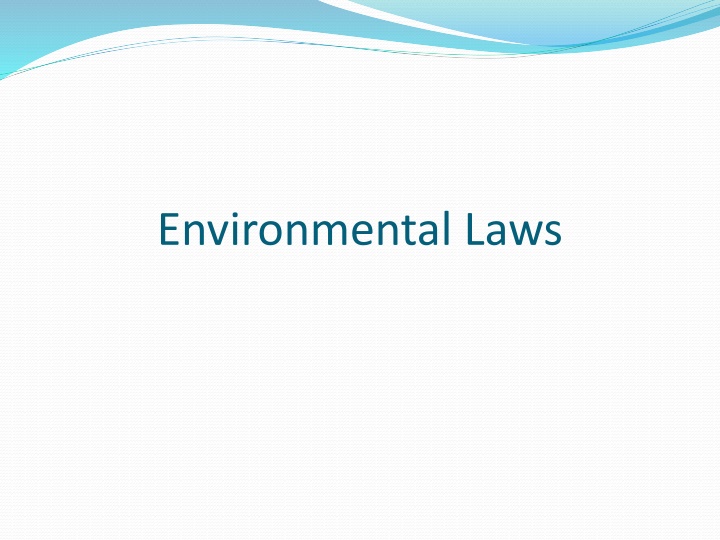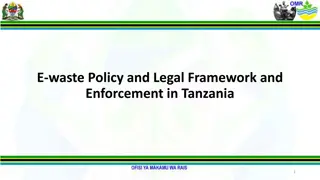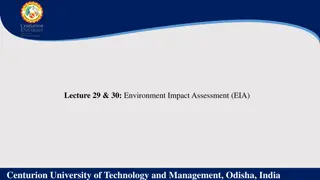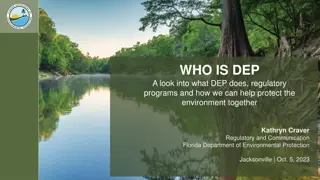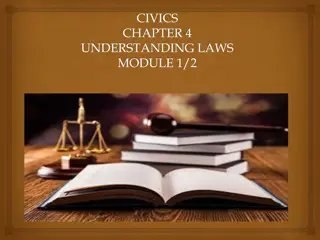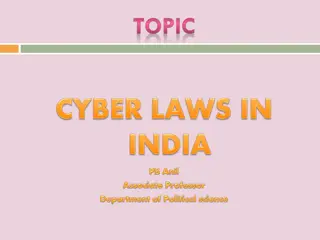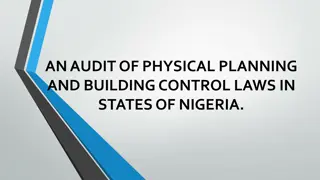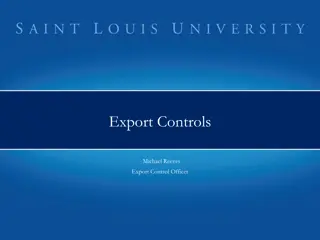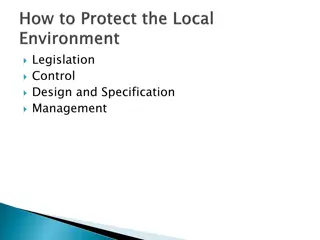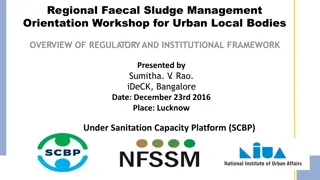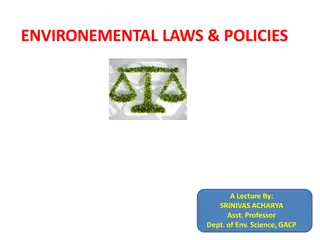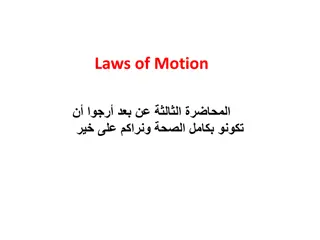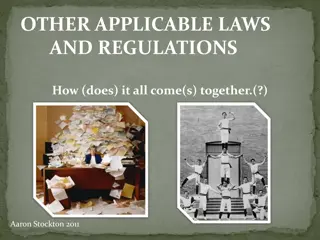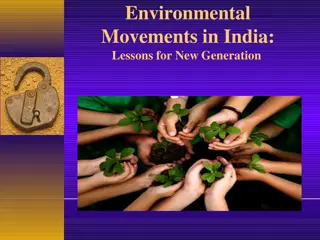Environmental Laws in India: Regulations and Framework
India has a robust framework for environmental laws with a history dating back to pre-independence times. The legislation received a significant boost after the UN Conference in 1972, leading to the formation of the Ministry of Environment and Forests in 1985. Constitutional provisions, such as Article 21, Article 48-A, and Article 51-A(g) ensure protection and improvement of the environment. The Ministry of Environment and Forests, along with various agencies, play vital roles in planning, enforcement, and promotion of environmental laws in the country. Key legislations cover general, water, air, and forest and wildlife aspects, with the General Environment Protection Act of 1986 serving as a crucial tool for environmental quality control and pollution reduction.
Download Presentation

Please find below an Image/Link to download the presentation.
The content on the website is provided AS IS for your information and personal use only. It may not be sold, licensed, or shared on other websites without obtaining consent from the author.If you encounter any issues during the download, it is possible that the publisher has removed the file from their server.
You are allowed to download the files provided on this website for personal or commercial use, subject to the condition that they are used lawfully. All files are the property of their respective owners.
The content on the website is provided AS IS for your information and personal use only. It may not be sold, licensed, or shared on other websites without obtaining consent from the author.
E N D
Presentation Transcript
In India, even before the independence, several environmental legislation existed but the real impetus for bringing about a well- developed framework came only after the UN Conference on the Human and Environment (Stockholm, 1972). Under the influence of this declaration, the National Council for Environmental Policy and Planning within the Department of Science and Technologywas set up in 1972. This Council later evolved into a full-fledged Ministry of Environment and Forests (MoEF) in 1985 which today is the apex administrative body in the country for regulating and ensuring environmental protection. After the Stockholm Conference, in 1976, constitutional sanction was given to environmental concerns through the 42ndAmendment, which incorporated them into the Directive Principles of State Policy and Fundamental Rights and Duties.
Constitutional Provisions & Environment Art 21 Right to pollution free environment. Art 48-A The state shall endeavor to protect & improve the environment and to safeguard the forests and wildlifeof thecountry. Art 51-A(g) duty of every citizen of India to protect and improve the natural environment including forests, lakes, rivers and compassion for living creatures. wildlife and to have
Ministry Government of India serves as the nodal agency for the planning, promotion, making of environment laws and their enforcement in India. Following are the other important agencies which help the MoEF in carrying out environment related activities: Central Pollution Control Board State Pollution Control Boards State Departments of Environment Union Territories (UT) Environmental Committees The Forest Surveyof India The Wildlife Instituteof India The National Afforestationand Eco-developmentBoard The Botanical and Zoological Survey of India, etc. of Environment and Forests (MoEF) of
Environmental Legislations 1. General 2. Water 3. Air 4. Forest and wildlife
General Environment Protection Act, 1986 This act authorizes the central government to protect and improve environmental quality, control and reduce pollution from all sources, and prohibit or restrict the setting and /or operation of any industrial facilityon environmental grounds. "environment" includes water, air and land and the inter- relationship which exists among and between water, air and land, and human beings, other living creatures, plants, microorganism and property "environmental pollutant" means any solid, liquid or gaseous substance present in such concentration as may be, or tend to be, injurious to environment; "environmental pollution" means environmentof anyenvironmental pollutant; the presence in the
Environment Protection Act, 1986 "handling", in relation to any substance, means the manufacture, processing, treatment, package, storage, transportation, use, collection, destruction, conversion, offering for sale, transferor the like of such substance; hazardous substance" means any substance or preparation which, by reason of its chemical or physio-chemical properties or handling, is liable to cause harm to human beings, other living creatures, plant, micro-organism, property or theenvironment; "occupier", in relation to any factory or premises, means a person who has control over the affairs of the factory or the premises and includes in relation to any substance, the person in possession of the substance; Requirements under EPA Sec 7- no person carrying on any industry, operation or process shall discharge or emit or permit to be discharged or emitted any environmental pollutant in excess of such standards as may be prescribed Sec 8 no person shall handle or cause to be handled any hazardous substance except in accordance with such procedure and after complying with such safeguards as may be prescribed
Some notifications issued under this Act are: Doon Valley Notification (1989), which prohibits the setting up of an industry in which the daily consumption of coal/fuel is more than 24 MT (million tonnes) perday in the Doon Valley. Coastal Regulation Zone Notification (1991), which regulates activities along coastal stretches. As per this notification, dumping ash or any other waste in the CRZ is prohibited. The thermal power plants (only foreshore facilities for transport of raw materials, facilities for intake of cooling water and outfall for discharge of treated waste water/cooling water) require clearance from the MoEF. Dhanu Taluka Notification (1991), under which the district of Dhanu Taluka has been declared an ecologically fragile region and setting up power plants in its vicinity is prohibited. Revdanda Creek Notification (1989), which prohibits setting up industries in the belt around the Revdanda Creek as per the rules laid down in the notification. The Environmental Impact Assessment Notification, (1994 and as amended in 1997). As per this notification: All projects listed under Schedule I require environmental clearance from the MoEF. Projects under the delicenced category of the New Industrial Policy also require clearance from the MoEF. of Development Projects
Ash Content Notification (1997), required the use of beneficiated coal with ash content not exceeding 34% with effect from June 2001, (the date later was extended to June 2002). This applies to all thermal plants located beyond one thousand kilometres from the pithead and any thermal plant located in an urban area or, sensitive area irrespective of the distance from the pithead except any pithead power plant. Taj Trapezium Notification (1998), provided that no power plant could be set up within the geographical limit of the Taj Trapezium assigned by the Taj Trapezium Zone Pollution (Prevention and Control) Authority. Disposal of Fly Ash Notification (1999) the main objective of which is to conserve the topsoil, protect the environment and prevent the dumping and disposal of fly ash discharged from lignite-based power plants. The salient feature of this notification is that no person within a radius of 50 km from a coal-or lignite-based power plant shall manufacture clay bricks or tiles without mixing at least 25% of ash with soil on a weight-to-weight basis. For the thermal power plants the utilisation of the flyash would beas follows: Every coal-or lignite-based power plant shall make available ash for at least ten years from the date of publication of the above notification without any payment or any other consideration, for the purpose of manufacturing ash- based products such as cement, concrete blocks, bricks, panels or any other material or for construction of roads, embankments, dams, dykes or for any otherconstruction activity.
All developmental projects whether or not under the Schedule I, if located in fragile regions mustobtain MoEF clearance. Industrial projects with investments above Rs 500 million must obtain MoEF clearance and are further required to obtain a LOI (Letter Of Intent) from the Ministry of Industry, and an NOC (No Objection Certificate) from the SPCB and the State Forest Department if the location involves forestland. Once the NOC is obtained, the LOI is converted intoan industrial licence by thestateauthority. The notification also stipulated procedural requirements for the establishment and operation of new power plants. As per this notification, two-stage clearance for site-specific projects such as pithead thermal power plants and valley projects is required. Site clearance is given in the first stage and final environmental clearance in the second. A public hearing has been made mandatory for projects covered by this notification. This is an important step in providing transparencyand a greaterrole to local communities.
General 1989 - The objective of Hazardous Waste (Management and Handling) Rules is to control the generation, collection, treatment, import, storage, and handling of hazardouswaste. 1998 - The Biomedical waste (Management and Handling) Rules is a legal binding on the health care institutions to streamline the process of proper handling of hospital waste such as segregation, disposal, collection, and treatment. 2000 - The Municipal Solid Wastes (Management and Handling) Rules, 2000 apply to every municipal authority responsible for the collection, segregation, storage, transportation, processing, and disposal of municipal solid wastes. 2002 - The Noise Pollution (Regulation and Control) (Amendment) Rules lay down such terms and conditions as are necessary to reduce noise pollution, permit use of loud speakers or public address systems during night hours on or during any cultural or religious festive occasion.
Water THE WATER (PREVENTION AND CONTROL OF POLLUTION) ACT, 1974 This act provides for the prevention and control of water pollution and the maintenance or restoration of wholesomeness of water. As such, all human activities having a bearing on water quality are covered under this Act. Subject to the provisions in the Act, no person without the pervious consent of the State Pollution Control Board (SPCB) can establish any industry, operation or any treatment and disposal system or an extension or addition there to which is likely to discharge sewage or trade effluent into a stream or well sewer or on hand and have to apply to the SPCB concerned to obtain the consent to establish as well as the consent to operate the industry after establishment.
Water 1977 - The Water (Prevention and Control of Pollution) Cess Act provides for the levy and collection of cess or fees on waterconsuming industries and local authorities. 1978 - The Water (Prevention and Control of Pollution) Cess Rules contains the standard definitions and indicate the kind of and location of meters that every consumer of water is required to affix 1991 - The Coastal Regulation Zone Notification puts regulations on various activities, including construction. It gives some protection to the backwaters and estuaries. 2010 Wetland Rules
Air THE AIR (PREVENTION AND CONTROL OF POLLUTION) ACT, 1981 The objective of the Air Act 1981 is to prevent, control and reduce airpollution including noise pollution. Under provisions of this Act, no person shall, without previous consent of the SPCB, establish or operate any industrial plant in air pollution control area the investor has to apply to the SPCB/Pollution Control Committee (PCB) to consent. No person operating any industrial plant shall emit any air pollution in excess of the standards laid down by the SPCB and have to comply with the stipulated conditions. 1987 - The Air (Prevention Amendment Act empowers the central and state pollution control boards to meetwith graveemergenciesof airpollution. and Control of Pollution)
Forest and wildlife 1927 - The Indian Forest Act and Amendment, 1984, is one of the many surviving colonial statutes. It was enacted to consolidate the law related to forest, the transit of forest produce, and the duty leviable on timber and other forest produce . 1972 - The Wildlife Protection Act, Rules 1973 and Amendment 1991 provides for protection to listed species of flora and fauna and establishes a network of ecologically-important protected areas. The WPA empowers the central and state governments to declare any area a wildlife sanctuary, national park or closed area. There is a blanket ban on carrying out any industrial activity inside these protected areas. It provides for authorities to administer and implement the Act; regulate the hunting of wild animals; protect specified plants, sanctuaries, national parks and closed areas; restrict trade or commerce in wild animals or animal articles; and miscellaneous matters. The Act prohibits hunting of animals except with permission of authorized officer when an animal has become dangerous to human life or property or so disabled or diseased as to be beyond recovery (WWF-India, 1999). The near-total prohibition on hunting was made more effective by the Amendment Act of 1991.
1980 - This Act was adopted to protect and conserve forests. The Act restricts the powers of the state in respect of de-reservation of forests and use of forestland for non- forest purposes (the term non-forest purpose includes clearing any forestland for cultivation of cash crops, plantation crops, horticulture or any purpose other than re- afforestation). 2002 - The Biological Diversity Act is an act to provide for the conservation of biological diversity, sustainable use of its components, and fair and equitable sharing of the benefits arising out of the use of biological resources and knowledge associated with it.
THE NATIONAL ENVIRONMENT TRIBUNAL ACT, 1995. The National Environment Tribunal Act, 1995 is enacted to provide for strict liability for damages arising out of indents occurring during handling of hazardous substances and National Environment expunction disposal of cases arising from such accidents, with a view compensation damages environment. for establishment Tribunal of effective and to giving person, relief and and the to
National Green Tribunal Act 2010 Passed by the Central Government. The stated objective of the Central Government was to provide a specialized forum for effective and speedy disposal of cases pertaining protection, conservation of forests and for seeking compensation for damages caused to people or property due to violation of environmental laws or conditions specified whilegranting permissions. to environment
Structure The Principal Bench of the NGT has been established in the National Capital New Delhi, with regional benches in: Pune (Western Zone Bench), Bhopal (Central Zone Bench), Chennai (Southern Bench) and Kolkata (Eastern Bench). Each Bench has a specified geographical jurisdiction covering several States in a region. There is also a mechanism forcircuit benches. For example, the Southern Zone bench, which is based in Chennai, can decide to have sittings in other places like Bangalore or Hyderabad.
Structure The Chairperson of the NGT is a retired Judge of the Supreme Court, Head Quartered in Delhi. Other Judicial members are retired Judges of High Courts. Each bench of the NGT will comprise of at leastone Judicial Memberand one Expert Member. Expert members should qualification and a minimum of 15 years experience in the field of environment/forest conservation and related subjects. have a professional
Powers The NGT has the power to hear all civil cases relating to environmental issues and questions that are linked to the implementation of laws listed in Schedule I of the NGT Act. These include the following: The Water (Prevention and Control of Pollution) Act, 1974; The Water (Prevention and Control of Pollution) Cess Act, 1977; The Forest (Conservation) Act, 1980; The Air (Prevention and Control of Pollution) Act, 1981; The Environment (Protection) Act, 1986; The Public Liability Insurance Act, 1991; The Biological Diversity Act, 2002.
Powers This means that any violations pertaining only to these laws, or any order / decision taken by the Government under these laws can be challenged before the NGT. The NGT has not been vested with powers to hear any matter relating to the Wildlife (Protection) Act, 1972, the Indian Forest Act, 1927 and various laws enacted by States relating to forests, tree preservation etc. Therefore, specific and substantial issues related to these laws cannot be raised before the NGT. You will have to approach the State High Court or the Supreme Court through a Writ Petition (PIL) or file an Original Suit before an appropriate Civil Judge of the taluk where the project thatyou intend to challenge is located.
Cases disposed by NGT Case relating to activities near the Ganga from its origin in Gaumukh Uttarakhand), the green tribunal ordered complete prohibition on any activity within 100 meters from the middleof the river. Passing a list of directions to ensure a pollution-free Ganga, one of them being the restriction of use of plastic around the area, Kumar said, There shall be a complete prohibition on use of plastic carrying bags, spoons, platesetc. to Haridwar (both in
Cases disposed by NGT The tribunal banned agricultural burning all over the country, particularly in Haryana, Delhi, Punjab, Rajasthan and Uttar Pradesh, and stipulated fines ranging from Rs.2,500-15,000 forviolations. The court also asked states to use satellites to monitor incidences of crop burning and directed them to provide machines, mechanism and equipment or its cost to the farmers to ensure that agricultural residue in the field in these states are removed, collected and stored atappropriate identified sites in each district.
Cases disposed by NGT Out of hundred of cases disposed by the tribunal, there were several cases where it ordered compensation for polluting theenvironment. In one such case, a distillery and sugar unit in Uttar Pradesh was permitted to carry on its business but subject to the condition that it pays Rs.1 crore environment compensation to the Uttar Pradesh Pollution Control Board and Rs.10 lakh bank guarantee for the damage caused to the environment and its restoration. Meanwhile, in a case relating to utilization of fly ash for making of bricks and allied products for construction, the tribunal held that fly ash or ash with high carbon content will not be covered under the notification and such industries could sell the products in the open market.
